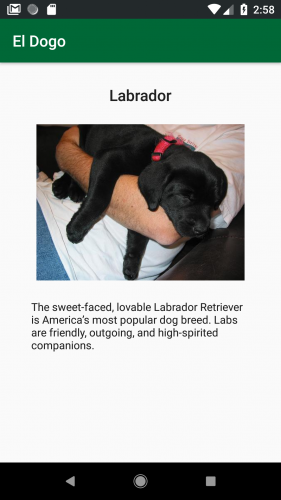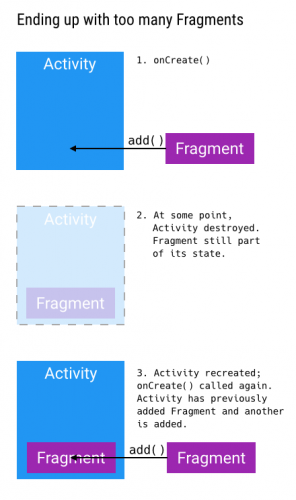Android Fragments Tutorial: An Introduction with Kotlin
In this Android Fragments with Kotlin tutorial you will learn the fundamental concepts of fragments while creating an app that displays dogs breeds. By Aaqib Hussain.
Sign up/Sign in
With a free Kodeco account you can download source code, track your progress, bookmark, personalise your learner profile and more!
Create accountAlready a member of Kodeco? Sign in
Sign up/Sign in
With a free Kodeco account you can download source code, track your progress, bookmark, personalise your learner profile and more!
Create accountAlready a member of Kodeco? Sign in
Sign up/Sign in
With a free Kodeco account you can download source code, track your progress, bookmark, personalise your learner profile and more!
Create accountAlready a member of Kodeco? Sign in
Contents
Android Fragments Tutorial: An Introduction with Kotlin
30 mins
- Getting Started With Android Fragments
- Android Fragment Lifecycle
- The V4 Support Library
- Creating a Fragment
- Using a factory method
- Adding a Fragment
- Adding a Fragment Dynamically
- Data Binding
- Communicating With the Activity
- Fragment Arguments and Transactions
- Binding Adapters
- Navigating the Fragment Back Stack
- Where To Go From Here?
Creating a Fragment
Eventually, El Dogo will show a list of dogs breeds on launch and tapping on any of the items will display details about that particular breed. To start, you’ll work backwards and first create the detail page.
Open the starter project in Android Studio and find fragment_dog_details.xml under app ▸ src ▸ main ▸ res ▸ layout. This XML file lays out the dog detail display. It also displays one of the drawable resources and the associated String resources.
Locate the DogDetailsFragment.ky file in the project. This class will be responsible for displaying details for a selected breed.
In DogDetailsFragment.kt, the code now looks like this:
import android.os.Bundle
import android.support.v4.app.Fragment
import android.view.LayoutInflater
import android.view.View
import android.view.ViewGroup
//1
class DogDetailsFragment : Fragment() {
//2
companion object {
fun newInstance(): DogDetailsFragment {
return DogDetailsFragment()
}
}
//3
override fun onCreateView(inflater: LayoutInflater,
container: ViewGroup?,
savedInstanceState: Bundle?): View? {
return inflater.inflate(R.layout.fragment_dog_details, container, false)
}
}
This code:
- Declares
DogDetailsFragmentas a subclass ofFragment. Notice theimport android.support.v4.app.Fragment: This is from the v4 support library mentioned before. - Provides a method for creating new instances of the fragment, a factory method.
- Creates the view for the fragment.
Activities use setContentView() to specify the XML file that defines their layouts, but fragments create their view hierarchy in onCreateView(). Here you called LayoutInflater.inflate to create the hierarchy of DogDetailsFragment.
The third parameter of inflate specifies whether the inflated fragment should be added to the container. The container is the parent view that will hold the fragment’s view hierarchy. You should always set this to false when inflating a view for a fragment: The FragmentManager will take care of adding the fragment to the container.
Using a factory method
There’s a new kid in town here: FragmentManager. Each activity has a FragmentManager that manages its fragments. It also provides an interface for you to access, add and remove those fragments.
You’ll notice that while DogDetailsFragment has a factory instance method, newInstance(), it does not have any constructors.
Wait, why do you need a factory method but not a constructor?
First, because you did not define any constructors, the compiler automatically generates an empty, default constructor that takes no arguments. This is all that you should have for a fragment: no other constructors.
Second, you probably know that Android may destroy and later re-create an activity and all its associated fragments when the app goes into the background. When the activity comes back, its FragmentManager starts re-creating fragments by using the empty default constructor. If it cannot find one, you get an exception.
For this reason, it is best practice to never specify any non-empty constructors. In fact, the easiest thing to do is to specify none as you did here.
What if you need to pass information or data to a Fragment? Hang on, you’ll get the answer to that later!
Adding a Fragment
Here’s where you get to add a fragment using the simplest approach — adding it to the activity’s XML layout. This is also sometimes called Adding a Fragment Statically.
To do this, open activity_main.xml, select the Text tab and add the following inside of the root FrameLayout:
<fragment
android:id="@+id/details_fragment"
class="com.raywenderlich.android.eldogo.DogDetailsFragment"
android:layout_width="match_parent"
android:layout_height="match_parent"/>
android:name="com.raywenderlich.android.eldogo.DogDetailsFragment" instead of class="com.raywenderlich.android.eldogo.DogDetailsFragment".
In this step, you’re placing a <fragment> tag inside of the activity layout and specifying the type of fragment the class attribute should inflate. FragmentManager requires the view ID of the <fragment>. By including this in the XML, the FragmentManager knows to add this fragment to the activity automatically.
Build and run. You will see the fragment:
Adding a Fragment Dynamically
First, open activity_main.xml again and remove the <fragment> you inserted. Embrace the Zen of deleting code! You’ll replace it with the list of dog breeds.
Open DogListFragment.kt, which has all the list code. You can see that the DogListFragment has no explicit constructors and a newInstance().
The list code in DogListFragment depends on some resources. You have to ensure that the fragment has a valid reference to a Context for accessing those resources. That’s where onAttach() comes into play.
In DogListFragment.kt and add these imports directly below the existing imports:
import android.os.Bundle
import android.support.v7.widget.GridLayoutManager
The GridLayoutManager helps in positioning items in the breed list. The other import is for standard fragment overrides.
Inside of DogListFragment.kt, add the following method above the definition of the DogListAdapter:
override fun onAttach(context: Context?) {
super.onAttach(context)
if (context != null) {
// Get dog names and descriptions.
val resources = context.resources
names = resources.getStringArray(R.array.names)
descriptions = resources.getStringArray(R.array.descriptions)
urls = resources.getStringArray(R.array.urls)
// Get dog images.
val typedArray = resources.obtainTypedArray(R.array.images)
val imageCount = names.size
imageResIds = IntArray(imageCount)
for (i in 0 until imageCount) {
imageResIds[i] = typedArray.getResourceId(i, 0)
}
typedArray.recycle()
}
}
onAttach() contains code that accesses the resources such as breed names and descriptions you need via the Context to which the fragment is attached. Because the code is in onAttach(), you can rest assured that the fragment has a valid Context.
Add this method right after the onAttach():
override fun onCreateView(inflater: LayoutInflater,
container: ViewGroup?,
savedInstanceState: Bundle?): View? {
val view: View = inflater.inflate(R.layout.fragment_dog_list, container,
false)
val activity = activity as Context
val recyclerView = view.findViewById<RecyclerView>(R.id.recycler_view)
recyclerView.layoutManager = GridLayoutManager(activity, 2)
recyclerView.adapter = DogListAdapter(activity)
return view
}
In onCreateView(), you inflate the view hierarchy of DogListFragment, which contains a RecyclerView, and perform some standard RecyclerView setup.
If you have to inspect a fragment’s view, onCreateView() is a good place to start because it generates the view.
Next open MainActivity.kt and add the following to the bottom of onCreate():
// 1
if (savedInstanceState == null) {
// 2
supportFragmentManager
// 3
.beginTransaction()
// 4
.add(R.id.root_layout, DogListFragment.newInstance(), "dogList")
// 5
.commit()
}
At this point, to get DogListFragment into MainActivity. You ask your new friend, FragmentManager, to add it.
Here you:
- Check that the
savedInstanceStateisnull. This is a way to see if it’s an initial open of the screen. - Grab the
FragmentManagerby referencingsupportFragmentManageras opposed tofragmentManager, since you are using support fragments. - Ask that
FragmentManagerto start a new transaction by callingbeginTransaction()— you probably figured that out yourself. - Specify the add operation that you want by calling
addand passing in:-
The view ID of a container for the fragment’s view hierarchy in the activity’s layout. If you take a look at
activity_main.xml, you’ll find@+id/root_layout. - The fragment instance you want to add.
-
A string that acts as a tag/identifier for the fragment instance. This allows the
FragmentManagerto later retrieve the fragment for you.
-
The view ID of a container for the fragment’s view hierarchy in the activity’s layout. If you take a look at
- Finally, ask the
FragmentManagerto execute the transaction by callingcommit().
In the code above, an if block contains the code that displays the fragment and checks that the activity doesn’t have saved state. When an activity saves, all of its active fragments are also saved. If you don’t perform this check, this could happen:
And you may feel like this:
The lesson: Always keep in mind how the saved state affects your fragments.
And with that, you’ve added the fragment!
Build, run and you’ll see a dog list once the app launches:
FragmentManager helped achieve this awesomeness through FragmentTransactions, which are basically fragment operations such as add and remove.




